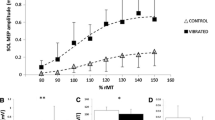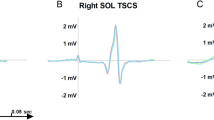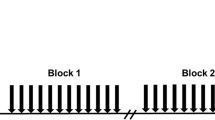Abstract
Daily Achilles tendon vibration has been shown to increase muscle force, likely via corticospinal neural adaptations. The aim of the present study was to determine the extent by which corticospinal excitability is influenced during direct Achilles tendon vibration. Motor-evoked potentials (MEPs) were elicited in the soleus (SOL), gastrocnemius medialis (GM) and tibialis anterior (TA) by transcranial magnetic stimulation of the motor cortical area of the leg with and without Achilles tendon vibration at various frequencies (50, 80 and 110 Hz). Contralateral homologues were also investigated. SOL and GM MEP amplitude significantly increased by 226 ± 188 and 66 ± 39 %, respectively, during Achilles tendon vibration, without any difference between the tested frequencies. No MEP changes were reported for TA or contralateral homologues. Increased SOL and GM MEP amplitude suggests increased vibration-induced corticospinal excitability independent of vibration frequency.



Similar content being viewed by others
Abbreviations
- GM:
-
Gastrocnemius medialis
- MEP:
-
Motor-evoked potential
- rMT:
-
Resting motor threshold
- SOL:
-
Soleus
- TA:
-
Tibialis anterior
- TMS:
-
Transcranial magnetic stimulation
References
Abbruzzese M, Minatel C, Faga D, Favale E (1997) Testing for pre-synaptic and post-synaptic changes in the soleus H reflex pathway following selective muscle vibration in humans. Neurosci Lett 231:99–102
Bawa P, Chalmers GR, Stewart H, Eisen AA (2002) Responses of ankle extensor and flexor motoneurons to transcranial magnetic stimulation. J Neurophysiol 88:124–132
Brouwer B, Ashby P (1990) Corticospinal projections to upper and lower limb spinal motoneurons in man. Electroencephalogr Clin Neurophysiol 76:509–519
Claus D, Mills KR, Murray NM (1988) Facilitation of muscle responses to magnetic brain stimulation by mechanical stimuli in man. Exp Brain Res 71:273–278
Devanne H, Lavoie BA, Capaday C (1997) Input–output properties and gain changes in the human corticospinal pathway. Exp Brain Res 114:329–338
Duchateau J (1995) Bed rest induces neural and contractile adaptations in triceps surae. Med Sci Sports Exerc 27:1581–1589
Eklund G, Hagbarth KE (1966) Normal variability of tonic vibration reflexes in man. Exp Neurol 16:80–92
Gandevia SC (2001) Spinal and supraspinal factors in human muscle fatigue. Physiol Rev 81:1725–1789
Gondin J, Guette M, Maffiuletti NA, Martin A (2004) Neural activation of the triceps surae is impaired following 2 weeks of immobilization. Eur J Appl Physiol 93:359–365. doi:10.1007/s00421-004-1225-z
Hermens HJ, Freriks B, Disselhorst-Klug C, Rau G (2000) Development of recommendations for SEMG sensors and sensor placement procedures. J Electromyogr Kinesiol 10:361–374
Kaelin-Lang A, Luft AR, Sawaki L, Burstein AH, Sohn YH, Cohen LG (2002) Modulation of human corticomotor excitability by somatosensory input. J Physiol 540:623–633
Kossev A, Siggelkow S, Schubert M, Wohlfarth K, Dengler R (1999) Muscle vibration: different effects on transcranial magnetic and electrical stimulation. Muscle Nerve 22:946–948
Kossev A, Siggelkow S, Kapels H, Dengler R, Rollnik JD (2001) Crossed effects of muscle vibration on motor-evoked potentials. Clin Neurophysiol 112:453–456
Lapole T, Pérot C (2010) Effects of repeated Achilles tendon vibration on triceps surae force production. J Electromyogr Kinesiol 20:648–654. doi:10.1016/j.jelekin.2010.02.001
Lapole T, Pérot C (2012) Hoffmann reflex is increased after 14 days of daily repeated Achilles tendon vibration for the soleus but not for the gastrocnemii muscles. Appl Physiol Nutr Metab 37:14–20. doi:10.1139/h11-129
Lapole T, Deroussen F, Perot C, Petitjean M (2012) Acute effects of Achilles tendon vibration on soleus and tibialis anterior spinal and cortical excitability. Appl Physiol Nutr Metab 37:657–663. doi:10.1139/h2012-032
Lapole T, Canon F, Perot C (2013) Ipsi- and contralateral H-reflexes and V-waves after unilateral chronic Achilles tendon vibration. Eur J Appl Physiol 113:2223–2231. doi:10.1007/s00421-013-2651-6
Macefield VG, Gandevia SC, Bigland-Ritchie B, Gorman RB, Burke D (1993) The firing rates of human motoneurons voluntarily activated in the absence of muscle afferent feedback. J Physiol 471:429–443
Marconi B, Filippi GM, Koch G et al (2011) Long-term effects on cortical excitability and motor recovery induced by repeated muscle vibration in chronic stroke patients. Neurorehabil Neural Repair 25:48–60. doi:10.1177/1545968310376757
McNeil CJ, Butler JE, Taylor JL, Gandevia SC (2013) Testing the excitability of human motoneurons. Front Hum Neurosci 7:152. doi:10.3389/fnhum.2013.00152
Mileva KN, Bowtell JL, Kossev AR (2009) Effects of low-frequency whole-body vibration on motor-evoked potentials in healthy men. Exp Physiol 94:103–116. doi:10.1113/expphysiol.2008.042689
Munte TF, Jobges EM, Wieringa BM, Klein S, Schubert M, Johannes S, Dengler R (1996) Human evoked potentials to long duration vibratory stimuli: role of muscle afferents. Neurosci Lett 216:163–166
Naito E, Ehrsson HH (2001) Kinesthetic illusion of wrist movement activates motor-related areas. NeuroReport 12:3805–3809
Naito E, Ehrsson HH, Geyer S, Zilles K, Roland PE (1999) Illusory arm movements activate cortical motor areas: a positron emission tomography study. J Neurosci 19:6134–6144
Perez MA, Lungholt BK, Nyborg K, Nielsen JB (2004) Motor skill training induces changes in the excitability of the leg cortical area in healthy humans. Exp Brain Res 159:197–205. doi:10.1007/s00221-004-1947-5
Proske U (1997) The mammalian muscle spindle. News Physiol Sci 12:37–42
Ridding MC, Brouwer B, Miles TS, Pitcher JB, Thompson PD (2000) Changes in muscle responses to stimulation of the motor cortex induced by peripheral nerve stimulation in human subjects. Exp Brain Res 131:135–143
Rittweger J (2010) Vibration as an exercise modality: how it may work, and what its potential might be. Eur J Appl Physiol 108:877–904. doi:10.1007/s00421-009-1303-3
Roll JP, Gilhodes JC, Tardy-Gervet MF (1980) Effects of vision on tonic vibration response of a muscle or its antagonists in normal man. Experientia 36:70–72
Roll JP, Vedel JP, Ribot E (1989) Alteration of proprioceptive messages induced by tendon vibration in man: a microneurographic study. Exp Brain Res 76:213–222
Rollnik JD, Siggelkow S, Schubert M, Schneider U, Dengler R (2001) Muscle vibration and prefrontal repetitive transcranial magnetic stimulation. Muscle Nerve 24:112–115
Rosenkranz K, Rothwell JC (2003) Differential effect of muscle vibration on intracortical inhibitory circuits in humans. J Physiol 551:649–660. doi:10.1113/jphysiol.2003.043752
Rosenkranz K, Rothwell JC (2006) Differences between the effects of three plasticity inducing protocols on the organization of the human motor cortex. Eur J Neurosci 23:822–829. doi:10.1111/j.1460-9568.2006.04605.x
Rosenkranz K, Pesenti A, Paulus W, Tergau F (2003) Focal reduction of intracortical inhibition in the motor cortex by selective proprioceptive stimulation. Exp Brain Res 149:9–16. doi:10.1007/s00221-002-1330-3
Siggelkow S, Kossev A, Schubert M, Kappels HH, Wolf W, Dengler R (1999) Modulation of motor evoked potentials by muscle vibration: the role of vibration frequency. Muscle Nerve 22:1544–1548
Steyvers M, Levin O, Verschueren SM, Swinnen SP (2003) Frequency-dependent effects of muscle tendon vibration on corticospinal excitability: a TMS study. Exp Brain Res 151:9–14. doi:10.1007/s00221-003-1427-3
Swayne O, Rothwell J, Rosenkranz K (2006) Transcallosal sensorimotor integration: effects of sensory input on cortical projections to the contralateral hand. Clin Neurophysiol 117:855–863. doi:10.1016/j.clinph.2005.12.012
Wiesendanger M, Miles TS (1982) Ascending pathway of low-threshold muscle afferents to the cerebral cortex and its possible role in motor control. Physiol Rev 62:1234–1270
Acknowledgments
We sincerely acknowledge Dr. Léonard Féasson for conducting medical inclusions and Régis Bonnefoy for technical assistance. We also thank Rodolphe Testa and Thierry Busso for helping with statistical analysis. J.T. was supported by a doctoral research grant from the Rhône-Alpes Region. P.A. was supported by a doctoral research grant from the General Directorate for Armament, Ministry of Defence (France).
Conflict of interest
The authors declare that they have no competing interests.
Author information
Authors and Affiliations
Corresponding author
Rights and permissions
About this article
Cite this article
Lapole, T., Temesi, J., Gimenez, P. et al. Achilles tendon vibration-induced changes in plantar flexor corticospinal excitability. Exp Brain Res 233, 441–448 (2015). https://doi.org/10.1007/s00221-014-4125-4
Received:
Accepted:
Published:
Issue Date:
DOI: https://doi.org/10.1007/s00221-014-4125-4




